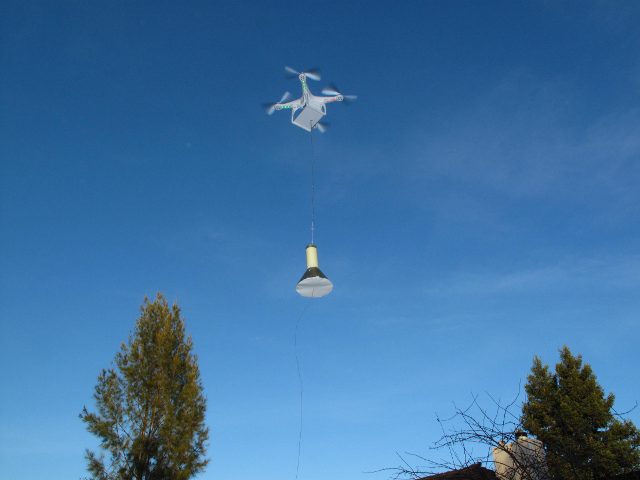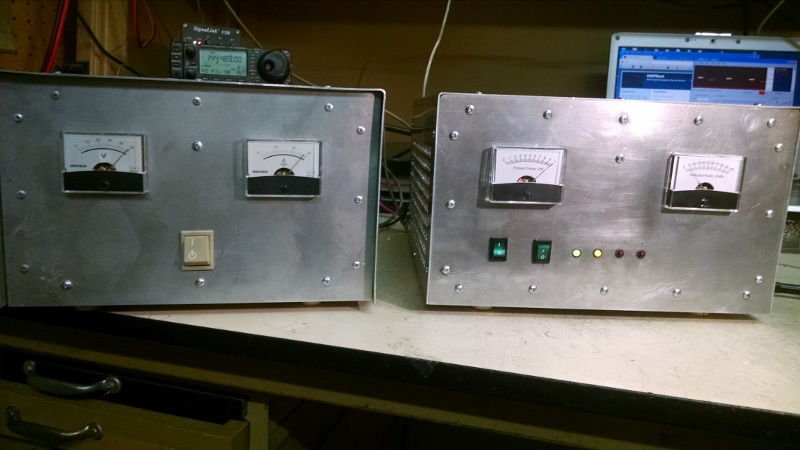
In addition to providing a very wide bandwidth information transmission system using existing power lines, SWTLs are interesting as a means of transmitting significant power for supporting high altitude antennas. A Video demonstrating ~40dB improvement to channel capacity through the use of a helium balloon aerostat, supporting a light weight wide-band antenna, fed with SWTL has already been shown.
A downside of balloon aerial supports is that they require a large amount of helium and large balloon size to lift significant weight and to withstand even moderate winds. For many applications a better alternative is to use a powered helicopter or multi-copter to both support the weight of the antenna and SWTL payload while also accurately maintaining position even in the presence of very significant wind.
Previously it has been necessary to use full-size aircraft to supply this function, a role that is arguably even more expensive than helium balloons or even blimps or dirigibles. However, in the last few years, inexpensive technology has made rotary wing model aircraft, such as electric helicopters, quadcopters and hexacopters both accessible and very affordable. Using these radio-controlled aircraft, or “drones” as they are increasingly called, with their significant multi-dimensional stabilization to support one or more antennas at high altitude which are being fed with a SWTL has become an attractive alternative to these previous, more expensive and more difficult approaches. These also provide the ability to be deployed very quickly for establishing temporary and emergency communications systems.
A major problem with using small electric aircraft as aerostats is flight time. Presently these all operate on self-contained battery
power. The weight of the batteries must be included in the total power required to support the aircraft. Because of the limited energy
capacity of even these modern cells, often lithium-polymer, flight times in the 10-20 minute range are generally about all that are
practical. Adding additional batteries to increase flight time also adds weight which must be lifted by the motors and a point of
diminishing returns is reached that makes further improvement to flight time impossible.
However, the same SWTL that is used to provide connection from ground-mounted communications equipment to the elevated antenna can
simultaneously support quite high power transmission for flight power for the aircraft. If, on a wavelength/frequency separate from
the communications channels, a high power transmitter transmits RF energy up the SWTL to the aircraft, that power can then be
rectified back to DC and used to operate the drone's motors. A ground-powered system like this has several “power supplies”.
Supplies (1) and (2) are ground-mounted and separated from airborne supplies (3) and (4) by the SWTL/tether.
Typical small multi-rotor model drones range in size from a few centimeters to more than a meter, measured between propeller axes.
Common drone sizes are from 350mm to 650mm. Craft of this size might require between 150W and 500W of power to maintain a hover in
the absence of wind. Thus, a flight system using a ground transmitter, SWTL, Rectifier and DC power converter might need to be
able to provide a significant fraction of one horsepower in order to operate continuously. The presence of wind or wind gusts
can increase these requirements somewhat further.
A typical ground-RF powered drone, flying at 100-200 meters and supporting both a SWTL and metalized-paper antenna, of the type
shown in the above video, might require average delivered DC power on the order of 200 watts to stay aloft continuously in modest
winds. Depending upon SWTL line type and launcher design a system designer might want to provide twice this amount of forward
power from the ground transmitter in order to cover system losses.
The flight-power transmitter might be operated at any of quite a range of frequencies since RF power amplifiers capable of providing
more than 1 kilowatt of power are no longer expensive. Amplifier modules, such as those offered by Freescale MRFE6VP1K25H and others,
are now not too expensive. These can operate in the 100-600 MHz region and provide up to1.3 kW of output power along with a
ruggedness that makes them suitable for this application.
Here is a photo of AC mains (1) and RF power (2) sources.

For these, input power of 1.7 kW (2.2 horsepower) at 240VAC is converted
to 50VDC at a power of 1.4 kW (1.9 horsepower) by the left supply and the DC supply power is converted to 1 kW (1.3 horsepower) at
144 MHz with a 50 ohm source impedance.
Besides the cost and availability of transmitting equipment, it is necessary to consider the reverse process – that of converting
the RF power at the top end of the SWTL back into DC power to operate the aircraft. This problem has a lot in common with that of
generating RF power, relatively high-power devices that operate efficiently at the frequency chosen must be used. In addition, at the
top it is important that all hardware be light weight since weight increases the system power requirements.
Preliminary designs of these rectifier circuits using Cree silicon-carbide diodes have proven capable of producing better than 90% conversion of RF power, up to 150 MHz, back to DC and are small, inexpensive and light weight.
Since launcher length generally increases with wavelength, it appears that using a frequency in the vicinity of 100-200 MHz for
ground-powering the drone is appropriate. Other frequencies, both higher and lower, could be used but require some additional
engineering design to achieve an optimum design.
For this reason, the initial tests of ground-powered drones, supporting antennas for wide area communications are being pursued
at 144 MHz.
Here is the above videoviewed on YouTube It demonstrates the delivery of DC power to a point 100 meters away over a .32 mm diameter wire. That same wire can tether and provide power to fly a GPS stabilized quadcopter while it simultaneously connects a ground mounted radio, mobile phone, WiFi router or similar communications device to a high antenna.
An illustration of a ground-powered drone being used to provide extended range communications for a first-person-view (FPV) video and telemetry system is shown here.

More SWTL information is available at
http://www.corridorsystems.com
and